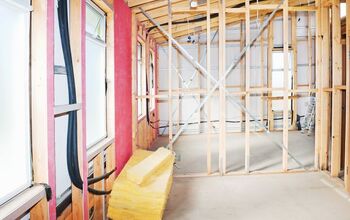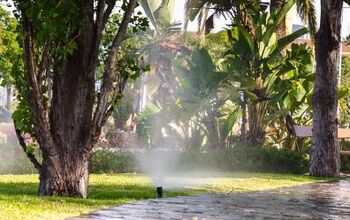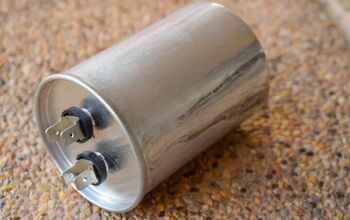Can You Put Plastic Vapor Barrier Over Faced Insulation? (Find Out Now!)

Insulating your home is a huge part of making your home liveable, comfortable, and efficient. There are very few climates in the US where insulation isn’t needed. In extreme climates, the importance of insulating your home becomes even greater. Many people wonder if putting a plastic vapor barrier over faced insulation is good for extra protection.
In general, there is no problem with a plastic vapor barrier over your faced insulation. In fact, in some climates, it may be a good idea. Faced insulation is rated as a vapor barrier but not an air barrier. Where air infiltration is a consideration, the addition of a plastic vapor barrier acts as an air barrier for added insulation.
Depending on your climate, the way you install the plastic vapor barrier may be different. For example, there are some caveats to putting a plastic vapor barrier on your home. In very hot climates with mild winters, you need a different approach to adding a plastic vapor barrier to your home. Here are our thoughts on plastic vapor barriers and faced insulation.
Do You Need Insulation Installers?
Get free, zero-commitment quotes from pro contractors near you.

What is Faced Insulation?
Faced insulation is typically bat fiberglass insulation with a facing applied to the fiberglass to hold it together. When properly installed, the facing material acts as a vapor barrier protecting your home from moisture infiltration from outside. Under most climate conditions fund in the United States, faced insulation is extremely effective.
The facing material used varies depending on the manufacturer and the intended application. For the most part, faced insulation in the United States has vapor barriers made from these materials.
- Kraft Paper
- Foiled Kraft Paper
- Aluminum Foil
- Vinyl
It should be noted that many building codes require some sort of covering over faced insulation to protect the facing from fire. In most homes, this wall covering is wallboard or sheetrock. Interior coverings of sheetrock or wallboard are effective air barriers themselves.
How Does Faced Insulation Work?
For faced insulation to be effective as a vapor barrier, it must be installed properly. In most homes, the exterior walls are the prime areas where faced insulation. The insulation is installed to protect against moisture infiltrating your home from the outside.
Faced insulation is designed to fit between the studs on a farmed wall. The insulation bat is cut to fit precisely in the sixteen-inch stud space. The facing material is cut approximately three-quarters of an inch wider to overlap onto the studs. Installers usually use staple guns to attach the facing material to the studs.
This method provides a secure vapor barrier that protects your home and provides excellent insulating qualities when installed correctly. An additional layer of air and vapor protection is added when wallboard or sheetrock is installed over the interior surfaces.
In some climates, faced insulation may be added to the ceiling space. This is usually where extremes in heat and cold are expected routinely.
What is Plastic Vapor Barrier?
A plastic vapor barrier is sheet polyethylene that is easily applied to walls as an additional barrier to air and moisture infiltration. In most cases, 6 mil plastic is used. There are other barrier materials, but in residential structures, plastic sheets are the most common.
You may find some plastic vapor barrier products referred to as Visqueen. Visqueen is a registered trademark of the British Polythene Industries Limited. It has become identified with all plastic sheet vapor barriers as a generic term.
When applied to a wall over faced insulation, it is generally applied as a single sheet from floor to ceiling and stapled to the studs when installed. If seams are needed between sheets, they are sealed with special polyethylene tapes designed for this purpose. In effect, you create a sealed space inside the area that lines with a plastic vapor barrier.
When Would Putting Plastic Vapor Barrier Over Faced Insulation Be a Good Idea?
There are some instances when installing a plastic vapor barrier over faced insulation is a good idea. In fact, in many parts of Canada, it is a building code requirement. An exterior plastic vapor barrier may be a good idea if you live in an extremely hot environment like the desert southwest of the United States.
Extremely Cod Environments
In areas that experience extremely cold environments for long periods, it is good to add a layer of a plastic vapor barrier over the faced insulation on the interior walls. The addition of a plastic vapor barrier protects the home in several ways.
- The plastic vapor barrier acts as an air barrier helping prevent air infiltration into the home. When properly installed, the unbroken layer of plastic prevents air movement into the home from the outdoors.
- There is a need to protect the faced insulation from moisture infiltration from inside the home in very cold climates. As moisture builds up inside, it has a tendency to infiltrate the faced insulation and can encourage the growth of mold and mildew in the insulation.
- A plastic vapor barrier can help prevent drafts which can adversely affect your HVAC system’s efficiency and effectiveness.
As we have mentioned, in some areas of Canada, a plastic vapor barrier is required by building codes. If you live where long periods of harsh cold winter weather are normal, you may want to consider adding a plastic vapor barrier over faced insulation. The additional vapor barrier may make your home more comfortable and liveable.
Extremely Hot and Dry Environments
In the desert southwest, putting a plastic vapor barrier on the interior wall can help prevent air infiltration. In addition, the plastic vapor barrier can prevent the warm moist air often found in homes in these climates from permeating into the faced insulation, causing moisture problems.
Typically, in these areas, the faced insulation provides enough vapor barrier protection, but many people opt to install an additional layer of plastic vapor barrier as a second layer of protection.
Hot and Humid Conditions
Coastal areas in the southeastern United States can cause moisture infiltration problems with faced insulation on exterior walls. As the AC cools and dries the air in the house, warm moist air can infiltrate. If the warm moist air hits a plastic vapor barrier on the inside of the framing, water can condense and dampen the insulation and the facing paper.
Wet insulation is prone to mold and mildew and can harbor enough moisture to attract insects and damage the wooden farming members. By placing the plastic vapor barrier on the exterior of the wall, this moisture infiltration is prevented.
Do You Need Insulation Installers?
Get free, zero-commitment quotes from pro contractors near you.

Vapor and Air Infiltration – Problems You Don’t Want
No matter where you reside or the climate you enjoy, vapor and air infiltration are things you want to avoid in your home. Adding a plastic vapor barrier is often a good idea when installed properly and in the right place in your home.

Dennis is a retired firefighter with an extensive background in construction, home improvement, and remodeling. He worked in the trades part-time while serving as an active firefighter. On his retirement, he started a remodeling and home repair business, which he ran for several years.
More by Dennis Howard











![10 Best Cordless Leaf Blowers – [2022 Reviews & Ultimate Guide]](https://cdn-fastly.upgradedhome.com/media/2023/07/31/9070789/10-best-cordless-leaf-blowers-2022-reviews-ultimate-guide.jpg?size=350x220)

![10 Best Scroll Saws for 2022 [Ultimate Reviews & Buyer's Guide]](https://cdn-fastly.upgradedhome.com/media/2023/07/31/9070684/10-best-scroll-saws-for-2022-ultimate-reviews-buyer-s-guide.jpg?size=350x220)


![How To Reset A Whirlpool Cabrio Washer [In 5 Easy Steps!]](https://cdn-fastly.upgradedhome.com/media/2023/07/31/9076531/how-to-reset-a-whirlpool-cabrio-washer-in-5-easy-steps.jpg?size=350x220)










